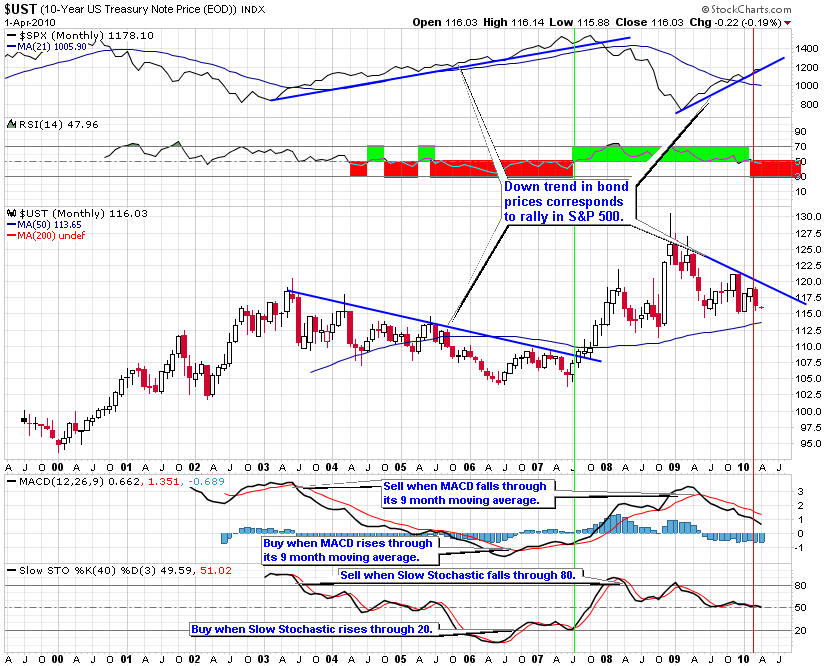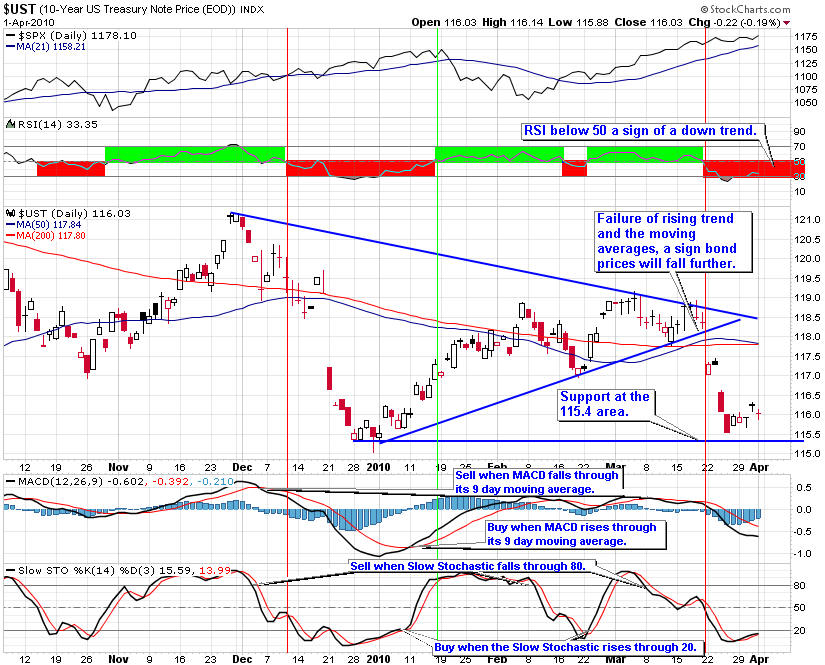4/5/2010
Stocks and bonds typically move in opposite directions. When bond prices go down stock prices go up. When bond prices fall, it is a sign that stock prices will continue to rise.
This is one of the reasons many financial advisors recommend that investors hold bonds and stocks, as they provide balance to their portfolio.
Portfolio managers will reduce their holdings of bonds when they believe interest rates will rise. Rising interest rates cause the value of existing bonds to fall. Some bond investors will adjust the term of their bond portfolio to try to minimize the negative affect of rising interest rates. Other will move some of their money to other asset classes that offer a better return such as stocks. Selling pressure on bonds will contribute to the downward pressure on bond prices.
While the stock market receives the most attention, the bond market is substantially larger. The global bond market is approximately $82.2 trillion, while the global stock market is worth $36.6 trillion. Any movement of cash from the bond market to the stock market will have a significant affect on stock prices. When bond prices fall, it encourages investors to move some of their money from bonds to stocks helping to fuel the rally. Can we use the alignment of bond prices and stock prices to help us adjust our portfolios to benefit from the rally in each?
Bond Rally Over
The rally in bond prices looks to be over. The eleven-year chart of the 10-year treasure bond prices shows the relationship of bond prices to stock prices. (Eleven years is all the further back the data is available for the 10-year Treasuries). In the middle of 2003, bond prices turned down. This aligns with the beginning of the rally in the stock market. The drop in bond prices ended a couple of months before the rally ended and we entered a new bear market. As the 10-year Treasury prices rallied, the market plunged. Then at the beginning of 2009, the rally in bonds stopped as the price of the 10-year Treasury turned down. This down trend corresponds with the rally in the stock market.
While there might be a minor support level at the 115 area on the 10-year Treasury, the downtrend in bond prices has much more room to fall. As long as this downtrend in bond prices continues, the rally in the stock market will continue. The RSI, MACD, and Slow Stochastic indicators confirm the downtrend in 10-year Treasuries. The also show the trend should continue for many more months. However, we might get a brief rebound in bond prices to the downtrend line.

Looking more closely at the 6-month daily chart of the 10-year Treasury bond prices, we can see the precipitous drop in the price that began in the last week of August 2010. A poor reception of a Treasury bond auction that week caused the fall of the 10-year Treasury along with other maturities. Almost each week we will see new Treasury bond auctions as the government must fund its large annual deficit.
With support at the 115 area, we might see a brief rally at this point back to the 117.5 area, a place that closely correlates with the downtrend on the monthly chart. If we get such a rally, it will be a negative for stocks, indicating we might pull back in the market.

Earnings Season is upon Us
Earnings season is upon us. Analysts are expecting 36% growth in earnings from 2009’s first quarter. For the market to rally, we will need to see companies beat these expectations. It should be no coincidence the last two market pullbacks of 5 to 10 percent occurred early in the earnings season. We might see the same this time around as many sectors are pricing in big profit surges that have the potential to disappoint. However, 2009 quarter was one of the worse earnings quarters making the comparison easier than normal.
Thompson expects the profit of financial companies to jump 193%, materials to leap 178% and consumer discretionary to rise 114%. This could be setting up investors for a disappointment, especially since so many people will be looking for earnings to exceed expectations. While these are huge numbers, earnings growth in the first quarter of 2009 was non-existent. It might not be that hard to meet expectations from such a low level.
The Bottom Line
Longer term the downtrend in bond prices is telling us to expect the market will trend up throughout 2010. As long as the downtrend in 10-year Treasuries continues, we can feel comfortable the up trend in stocks will continue.
Like any up trend, there will be pullbacks that offer new buying opportunities. We might be on the cusp of one such pull back with an overbought market and we are entering earnings season. Use any pull back to add to long positions form your stock watch list. It looks like the market will climb this wall of worry for longer than many think.
